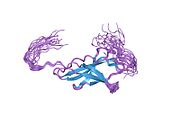Practical Applications of a SDMS (Scientific Data Management System)
Contents
Neuronal cell adhesion molecule is a protein that in humans is encoded by the NRCAM gene.[5][6]
Cell adhesion molecules (CAMs) are members of the immunoglobulin superfamily. This gene encodes a neuronal cell adhesion molecule with multiple immunoglobulin-like C2-type domains and fibronectin type-III domains. This ankyrin-binding protein is involved in neuron-neuron adhesion and promotes directional signaling during axonal cone growth. This gene is also expressed in non-neural tissues and may play a general role in cell-cell communication via signaling from its intracellular domain to the actin cytoskeleton during directional cell migration. Allelic variants of this gene have been associated with autism[7] and addiction vulnerability. Alternative splicing results in multiple transcript variants encoding different isoforms.[6]
References
- ^ a b c GRCh38: Ensembl release 89: ENSG00000091129 – Ensembl, May 2017
- ^ a b c GRCm38: Ensembl release 89: ENSMUSG00000020598 – Ensembl, May 2017
- ^ "Human PubMed Reference:". National Center for Biotechnology Information, U.S. National Library of Medicine.
- ^ "Mouse PubMed Reference:". National Center for Biotechnology Information, U.S. National Library of Medicine.
- ^ Lane RP, Chen XN, Yamakawa K, Vielmetter J, Korenberg JR, Dreyer WJ (Dec 1996). "Characterization of a highly conserved human homolog to the chicken neural cell surface protein Bravo/Nr-CAM that maps to chromosome band 7q31". Genomics. 35 (3): 456–65. doi:10.1006/geno.1996.0385. PMID 8812479.
- ^ a b "Entrez Gene: NRCAM neuronal cell adhesion molecule".
- ^ Marui T, Funatogawa I, Koishi S, et al. (2008). "Association of the neuronal cell adhesion molecule (NRCAM) gene variants with autism". Int J Neuropsychopharmacol. 12 (1): 1–10. doi:10.1017/S1461145708009127. PMID 18664314.
Further reading
- Grumet M (1997). "Nr-CAM: a cell adhesion molecule with ligand and receptor functions". Cell Tissue Res. 290 (2): 423–8. doi:10.1007/s004410050949. PMID 9321706. S2CID 24012715.
- Sakurai T, Lustig M, Nativ M, et al. (1997). "Induction of neurite outgrowth through contactin and Nr-CAM by extracellular regions of glial receptor tyrosine phosphatase beta". J. Cell Biol. 136 (4): 907–18. doi:10.1083/jcb.136.4.907. PMC 2132488. PMID 9049255.
- Nagase T, Ishikawa K, Nakajima D, et al. (1997). "Prediction of the coding sequences of unidentified human genes. VII. The complete sequences of 100 new cDNA clones from brain which can code for large proteins in vitro". DNA Res. 4 (2): 141–50. doi:10.1093/dnares/4.2.141. PMID 9205841.
- Wang B, Williams H, Du JS, et al. (1998). "Alternative splicing of human NrCAM in neural and nonneural tissues". Mol. Cell. Neurosci. 10 (5–6): 287–95. doi:10.1006/mcne.1997.0658. PMID 9604207. S2CID 12028546.
- Moré MI, Kirsch FP, Rathjen FG (2001). "Targeted ablation of NrCAM or ankyrin-B results in disorganized lens fibers leading to cataract formation". J. Cell Biol. 154 (1): 187–96. doi:10.1083/jcb.200104038. PMC 2196853. PMID 11449000.
- Dry K, Kenwrick S, Rosenthal A, Platzer M (2001). "The complete sequence of the human locus for NgCAM-related cell adhesion molecule reveals a novel alternative exon in chick and man and conserved genomic organization for the L1 subfamily". Gene. 273 (1): 115–22. doi:10.1016/S0378-1119(01)00493-0. PMID 11483367.
- Jenkins SM, Bennett V (2002). "Ankyrin-G coordinates assembly of the spectrin-based membrane skeleton, voltage-gated sodium channels, and L1 CAMs at Purkinje neuron initial segments". J. Cell Biol. 155 (5): 739–46. doi:10.1083/jcb.200109026. PMC 2150881. PMID 11724816.
- Aitkenhead M, Wang SJ, Nakatsu MN, et al. (2002). "Identification of endothelial cell genes expressed in an in vitro model of angiogenesis: induction of ESM-1, (beta)ig-h3, and NrCAM". Microvascular Research. 63 (2): 159–71. doi:10.1006/mvre.2001.2380. PMID 11866539.
- Pavlou O, Theodorakis K, Falk J, et al. (2002). "Analysis of interactions of the adhesion molecule TAG-1 and its domains with other immunoglobulin superfamily members". Mol. Cell. Neurosci. 20 (3): 367–81. doi:10.1006/mcne.2002.1105. PMID 12139915. S2CID 714233.
- Conacci-Sorrell ME, Ben-Yedidia T, Shtutman M, et al. (2002). "Nr-CAM is a target gene of the beta-catenin/LEF-1 pathway in melanoma and colon cancer and its expression enhances motility and confers tumorigenesis". Genes Dev. 16 (16): 2058–72. doi:10.1101/gad.227502. PMC 186445. PMID 12183361.
- Nakayama M, Kikuno R, Ohara O (2003). "Protein-protein interactions between large proteins: two-hybrid screening using a functionally classified library composed of long cDNAs". Genome Res. 12 (11): 1773–84. doi:10.1101/gr.406902. PMC 187542. PMID 12421765.
- Strausberg RL, Feingold EA, Grouse LH, et al. (2003). "Generation and initial analysis of more than 15,000 full-length human and mouse cDNA sequences". Proc. Natl. Acad. Sci. U.S.A. 99 (26): 16899–903. Bibcode:2002PNAS...9916899M. doi:10.1073/pnas.242603899. PMC 139241. PMID 12477932.
- Hillier LW, Fulton RS, Fulton LA, et al. (2003). "The DNA sequence of human chromosome 7". Nature. 424 (6945): 157–64. Bibcode:2003Natur.424..157H. doi:10.1038/nature01782. PMID 12853948.
- Custer AW, Kazarinova-Noyes K, Sakurai T, et al. (2003). "The role of the ankyrin-binding protein NrCAM in node of Ranvier formation". J. Neurosci. 23 (31): 10032–9. doi:10.1523/JNEUROSCI.23-31-10032.2003. PMC 6740847. PMID 14602817.
- Ota T, Suzuki Y, Nishikawa T, et al. (2004). "Complete sequencing and characterization of 21,243 full-length human cDNAs". Nat. Genet. 36 (1): 40–5. doi:10.1038/ng1285. PMID 14702039.
- Hutcheson HB, Olson LM, Bradford Y, et al. (2004). "Examination of NRCAM, LRRN3, KIAA0716, and LAMB1 as autism candidate genes". BMC Med. Genet. 5: 12. doi:10.1186/1471-2350-5-12. PMC 420465. PMID 15128462.
- Bonora E, Lamb JA, Barnby G, et al. (2005). "Mutation screening and association analysis of six candidate genes for autism on chromosome 7q". Eur. J. Hum. Genet. 13 (2): 198–207. doi:10.1038/sj.ejhg.5201315. PMID 15523497.
- Ishiguro H, Liu QR, Gong JP, et al. (2006). "NrCAM in addiction vulnerability: positional cloning, drug-regulation, haplotype-specific expression, and altered drug reward in knockout mice". Neuropsychopharmacology. 31 (3): 572–84. doi:10.1038/sj.npp.1300855. PMID 16123759.


























